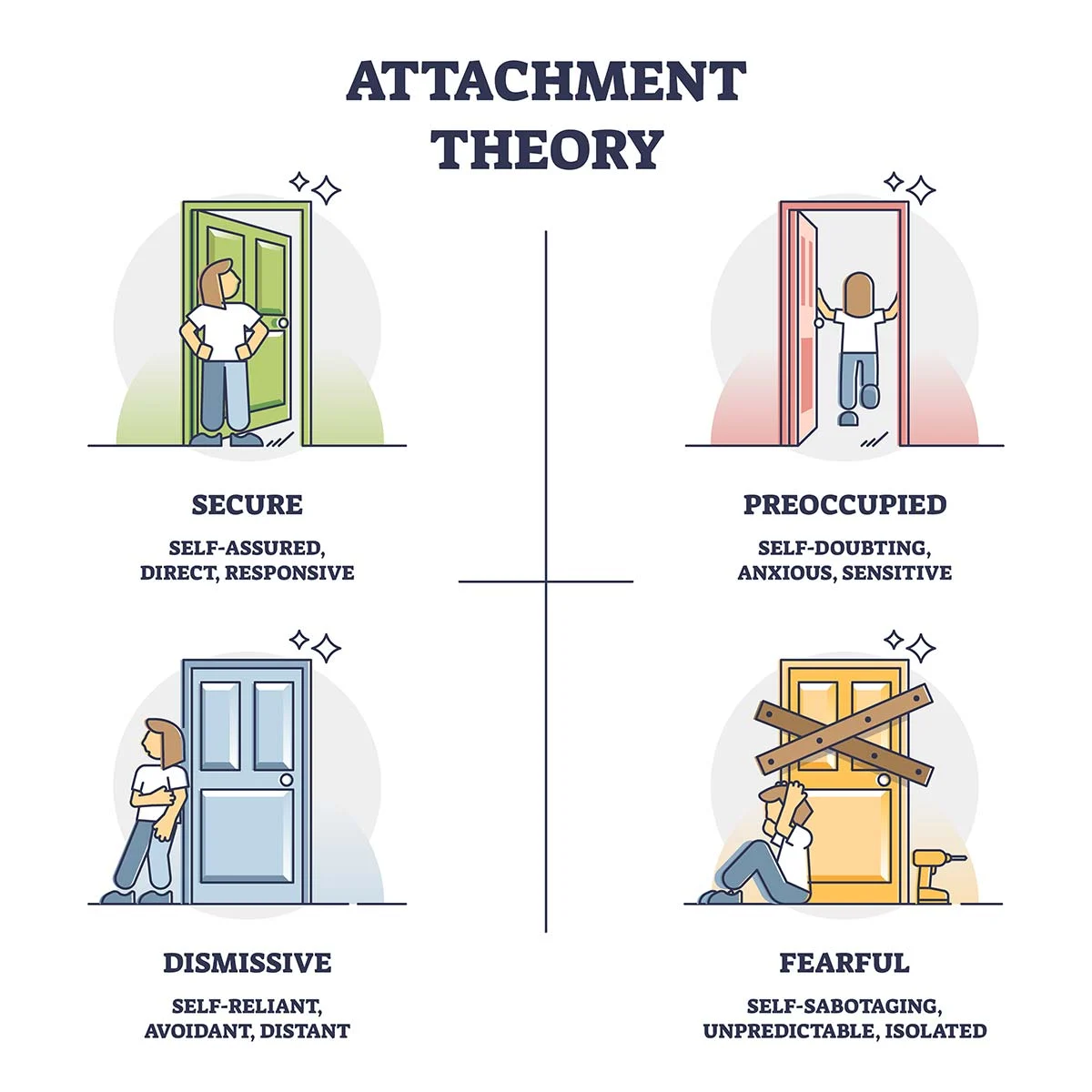Attachment theory, created by therapist John Bowlby, suggests that early collaborations among newborn children and their guardians shape a person’s mental and profound turn of events, which thusly impacts their grown-up connections. Connection styles allude to the trademark manners by which people see and answer profound closeness, closeness, and reliance in their connections. There are regularly four fundamental connection styles: secure, restless engrossed, contemptuous avoidant, and unfortunate avoidant (otherwise called disorganized).
Secure Attachment:
People with secure connection styles will generally have a positive perspective on themselves and their accomplices. They are alright with both closeness and freedom, esteeming profound association while additionally keeping up with solid limits. Individuals with secure connections are bound to impart transparently, look for and offer help, and handle clashes in a useful way. Their healthy identity worth isn’t vigorously reliant upon their connections, making them more versatile and tough in different relationship settings.
Anxious-Preoccupied Attachment
Those with a restless connection style frequently feel a powerful urge for closeness and dread surrender. They might stress over their accomplice’s sentiments and aims, every now and again looking for consolation to reduce their tensions. Individuals with this style could show extremely profound ups and downs and may turn out to be excessively reliant upon their accomplices for approval and confidence. They can be inclined to decipher equivocal circumstances as pessimistic and may experience issues dealing with their close-to-home responses.
Dismissive-Avoidant Attachment:
People with a pompous avoidant connection style will generally underline freedom and independence. They might make light of the significance of close-to-home associations and be hesitant to depend on others for help. While they could participate in connections, they frequently keep profound separations to forestall weakness. These people might experience issues communicating their own feelings and may excuse the feelings of their accomplices.
Fearful-Avoidant (Disorganized) Attachment:
This connection style is portrayed by a blend of restless and avoidant propensities. Individuals with an unfortunate avoidant connection style frequently want profound closeness, yet they likewise dread being harmed or dismissed. This contention can prompt profound social irregularity in connections. They could switch back and forth between looking for and staying away from closeness, creating turmoil and unconventionality for them as well as their accomplices.
Connection styles are not fixed and can be affected by different elements, including previous encounters, childhood, and self-awareness. Moreover, they can be changed or altered over the long haul through mindfulness, treatment, and creating better relationship elements.
| Secure Attachment | Anxious Attachment | Dismissive Attachment | Fearful Attachment |
| Good Communication | Practice self-sympathy | Have Vulnerability | Develop self-awareness |
| Open to closeness | Put down clear stopping points | Emotional needs to be communicated | Look for proficient assistance if needed |
| OK with independence | Challenge negative considerations | Emotional distance is challanged | Slowly overcome fears |
| healthy resolution of conflict | Emotional distance is challenged | Participate in intelligent exercises | strengthen support system |
| Look for and offer help | Participate in unwinding techniques | Encouragement of emotional connection | Embrace self-improvement |
Models
Bartholomew’s Four-Classification Model:
Created by Cindy Hazan and Phillip Shaver, this model expands upon the connection hypothesis by sorting grown-up connection styles into four aspects:
Secure: People with positive perspectives on themselves as well as other people, alright with closeness and freedom.
Preoccupied: People with high uneasiness and positive perspectives on others yet pessimistic perspectives on themselves. They look for steady consolation and endorsement.
Dismissing: People with positive perspectives on themselves yet pessimistic perspectives on others. They will generally stay away from close-to-home closeness and could excuse the significance of connections.
Fearful: People with pessimistic perspectives on both themselves as well as other people. They frequently battle with profound closeness because of past bad encounters.
This model adds intricacy to connection styles by considering both confidence and connection aspects.
Attachment Theory and Close Relationships Model:
Proposed by Collins and Feeney, this model investigates how connection styles impact methodologies people use to deal with profound closeness and distance in connections. The model underlines the accompanying systems:
Accessibility of the Partner: How people see the responsiveness and unwavering quality of their accomplice.
Seeking Support: How people connect with their accomplices for consistent reassurance.
Avoidance of Intimacy How people deal with the craving for closeness and the feeling of dread toward reliance.
The model recommends that connection styles shape these procedures, which, thusly, influence relationship elements.
Journey of Attachment Styles in Everyday Life
- Attachment Continuum: Attachment styles exist on a continuum instead of being unbending classes. People could display a mix of qualities from various styles, and their connection style can shift across various connections and circumstances.
- Attachment and Nurturing: Attachment styles can impact nurturing ways of behaving. Those with secure connections will more often than not give supporting and responsive providing care, while those with shaky attachment could battle to reliably meet their kid’s feelings.
- Attachment and Mental Well-being: Unreliable attachment styles can add to psychological wellness challenges. The restless attachment can prompt uneasiness problems, while avoidant attachment could associate with wretchedness and troubles in looking for help.
- Transgenerational Examples: Connection styles can be gone down through the ages. A guardian’s connection style can influence how they bring up their own kids, sustaining connection designs.
- Interior Working Models: Connection encounters shape interior working models — mental structures that impact discernments, convictions, and assumptions regarding oneself, others, and connections. These models guide conduct and cooperation.
- Secure Base and Investigation: Similarly, as guardians act as a protected base for kids, better halves can likewise give a solid base for investigation and development. Safely connected people have a solid sense of security to investigate their inclinations and seek self-improvement.
- Attachment in Dear Fellowships: Connection elements are not restricted to close connections. Connection styles can likewise impact how people connect with dear companions, affecting the degree of trust, support, and profound closeness.
- Jealousy and Attachment: Uncertain attachment styles, especially restless and distracted, can add to elevated desire and possessiveness in connections because of separation anxieties.
- Trust and Attachment: Trust is a vital part of the attachment. Safely appended people will generally have more significant levels of confidence in themselves and their accomplices, while unreliably connected people could battle with trust issues.
- Intergenerational Transmission: Connection styles can be passed from guardians to kids through different systems, including demonstrating conduct, providing care rehearses, and acquiring hereditary qualities.
- Romantic Relationship and Attachment: Accomplices with viable connection styles could encounter smoother relationship elements. Nonetheless, blended connection styles can likewise work with viable correspondence and shared understanding.
- Effect of Life-altering Situations: Life-altering situations like injury or huge changes can impact attachment elements. For example, a safe individual could turn out to be more restless in light of a significant life stressor.
- Attachment Styles and Separations: Attachment styles can impact how people adapt to separations. Restless people could battle with delayed trouble, while avoidant people could isolate rapidly.
Advisors frequently consider clients’ connection styles while chipping away at relationship issues or individual worries, as connection elements can give bits of knowledge into basic profound examples.
Self Coping Strategies
Positively, here are some self-survival methods that can be useful for people attempting to further develop their connection styles and oversee weaknesses in connections:
- Self-Awareness: Find the opportunity to ponder your connection designs and their beginnings. Mindfulness is the most important move towards rolling out certain improvements.
- Practice mindfulness to remain present at the time and oversee compelling feelings. Care methods can assist you with answering as opposed to responding incautiously.
- Journaling: Keep a diary to follow your contemplations, sentiments, and examples in your connections. This can assist you with distinguishing triggers and examples that you need to change.
- Positive Self-Talk: Challenge negative self-convictions and supplant them with positive certifications. Help yourself to remember your assets and value.
- Defining Limits: Figure out how to define and impart solid limits in connections. This assists you with safeguarding your close-to-home prosperity and encourages regard.
- Looking for Help: Contact companions, relatives, or a specialist while you’re feeling overpowered. Talking about your thoughts can give solace and viewpoint.
- Reinforce Confidence: Participate in exercises that help your confidence and certainty. Seek after side interests, put forth and accomplish little objectives, and praise your triumphs.
- Appreciation Practice: Develop an everyday appreciation practice to zero in on the positive parts of your life and connections. This can assist with moving your viewpoint.
- Careful Correspondence: Practice undivided attention and open correspondence with your connections. Being mindful and understanding can encourage association.
- Challenge Mental Contortions: Distinguish and challenge mental twists, like high-contrast thinking or rushing to make judgment calls. Supplant them with additional reasonable considerations.
Conclusion
In summary, attachment styles developed in childhood greatly influence how we relate to others as adults. There are four main styles: secure, anxious, dismissive-avoidant, and fearful-avoidant. Secure individuals balance intimacy and independence well. Anxious people crave closeness and fear abandonment. Dismissive-avoidant people prioritize self-sufficiency, while fearful-avoidant people struggle with both closeness and distance.
Attachment styles affect communication, conflict resolution, and relationship satisfaction. While styles can change with personal growth and therapy, recognizing your style is the first step. Seeking professional help, practicing self-care, and learning effective communication can help in building healthier relationships. Understanding attachment styles and working on personal growth can lead to more secure, fulfilling connections with others.
References
- Bartholomew, K., & Horowitz, L. M. (1991). Attachment styles among young adults: A test of a four-category model. Journal of Personality and Social Psychology, 61(2), 226-244.
- Collins, N. L., & Feeney, B. C. (2004). Working models of attachment shape perceptions of social support: Evidence from experimental and observational studies. Journal of Personality and Social Psychology, 87(3), 363-383.
- Crittenden, P. M. (2008). Raising Parents: Attachment, Parenting, and Child Safety. Willan.





